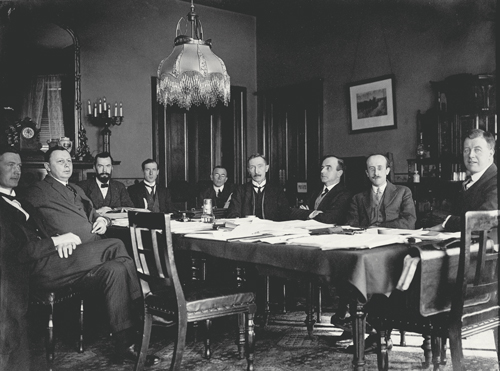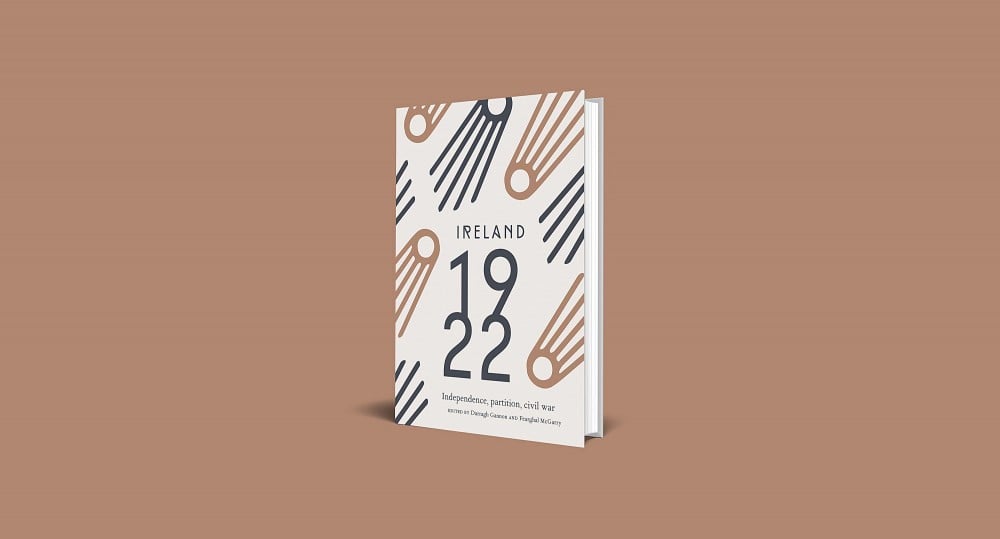6 December 1922: The Irish Free State Constitution Becomes Law
Defining Independence
by Bill Kissane
The constitution of the Irish Free State became law on 6 December 1922. Under the terms of the Anglo-Irish Treaty, signed on 6 December 1921, the constitution had to come into force within a year. The third Dáil was elected as a constituent assembly on 16 June, and first considered the draft constitution on 18 September. After several amendments, it was ratified on 25 October, and received approval at Westminster on 5 December. Thus 1922 gave Sinn Féin an historic opportunity to express its values in a legal constitution. Its success in doing so would depend on how it balanced the competing claims of democracy, imperialism and nationalism.
When the constitutional committee first met on 24 January 1922, Michael Collins had pointed to a Treaty clause that conferred on the Irish Free State ‘co-equal’ status with Canada. Anti-treatyites saw in this formula subordination; pro-treatyites hoped for evolution. The committee subsequently held 27 meetings. Collins attended only the first. Darrell Figgis, a poet and critic, chaired in his absence. Formally, the committee consisted of Collins as chair, Figgis, vice-chairman and secretary, and eight other men, including Hugh Kennedy (law adviser to the Provisional Government). Five committee members were legal experts, and four were civil servants. Three were former leaders of the Irish White Cross, and one, James Douglas, a Quaker businessman, would figure in peace initiatives during the civil war.
Their cosmopolitan approach was exemplified by the compilation of Select constitutions of the world, a volume containing the constitutions of Yugoslavia, Poland, Austria, Estonia, Czechoslovakia, Germany, the Soviet Union, Mexico, Denmark, Australia, France, Switzerland, Canada, Belgium, Norway, Sweden and the United States. It was presented to the third Dáil, by order of the Provisional Government, in September 1922. This volume was to assist the constituent assembly in its deliberation of the draft constitution that had been decided upon in June.
In its work drafting the constitution the committee also used collections of specialist documents: on functional representation, the southern unionists, the executive, the referendum, proportional representation and the judiciary. Where possible, its recommendations were kept simple and flexible, given the uncertain conditions, north and south.¹ The constitution was intended as a non-party document. The committee produced three drafts (A, B, and C), two of which were submitted to Collins on 7 March. Draft C, produced by James Murnaghan and Alfred O’Rahilly, was never taken seriously. Draft B, supported by most of the committee’s members, was submitted to the British government in June, but after weeks of negotiations both sides settled for a revised draft, based on A. Published on 16 June, the day of the general election, this is the draft that was considered by the Dáil in September, although none of the original drafts were made available to it.
Dominion status under the Treaty ruled out a formal republic. Yet Article 2 of the constitution began ‘All powers of government and all authority legislative, executive and judicial, in Ireland are derived from the people of Ireland’. The earliest constitutions in Select constitutions placed the weight of power in the executive, while those from the nineteenth century privileged legislative institutions. The more recent European constitutions tended to place more and more power in the hands of the people themselves. By 1920 most of Europe west of the Soviet Union was under democratic rule. ‘Popular government’ was associated with strong uni-cameralism, control of the executive, and individual and minority rights.² Figgis compared the new Irish state to a pyramid, with the people at the base, and the executive at the top.³ The Irish Free State constitution provided for parliamentary control of the executive, for proportional representation, and for the use of the referendum and popular initiative. It enfranchised women under thirty, before Britain did so; the legislation simply amended the British 1918 ‘Representation of the People Act’, replacing the references to Westminster and the United Kingdom with Dáil Éireann and Ireland.⁴
Negotiations between Hugh Kennedy on behalf of the constitutional committee and Lord Hewart for the British side in June 1922 were intended to guarantee the rights of southern unionists and to ensure that the constitution set no precedent for the break-up of the British empire. Hence the preliminary clause stating that any future amendment inconsistent with the Treaty’s terms would be void and inoperative. This made the Treaty, not the constitution, the supreme law. Originally, Michael Collins had instructed the constitutional committee not to incorporate the terms of the Treaty into their drafts. Alfred O’Rahilly later complained that the process of founding the Irish Free State had been assimilated to that of establishing a colony.⁵ In contrast, the British constitutional expert, Sir Arthur Berriedale Keith, argued that the constitution recognised the sovereignty of the people of Ireland, ‘leaving utterly vague’ the relations of Britain and Ireland.⁶ The Free State constitution continued on the Home Rule tradition of seeing minority rights as integral to democracy. Its prescription of ‘the principles of proportional representation’ reflected commitments made to the southern unionists by Arthur Griffith during the Treaty negotiations. A similar rationale influenced the composition of the first Senate.
The constituent assembly had the formal authority to amend, ratify or reject the constitution. The Labour party naively hoped that the final document would reflect the Dáil’s 1919 Democratic Programme. Yet the constitution was rushed through the assembly without major changes. The absence (due to the civil war) of anti-Treaty TDs meant that pro-Treaty Sinn Féin dominated proceedings. The main bones of contention for republicans were the role of the Crown in the legislative process, the office of the Governor General, and the divisive requirement for TDs to take an oath to the constitution and to the Crown. The constitution was the first test of Collins’s ‘stepping-stone’ approach to the Treaty, but the oath tilted the country in the direction of civil war.
Partition was another bone of contention. The preamble to the 1922 constitution expressed confidence that national unity would be restored.
After the constitution’s enactment, Northern Ireland could opt out of the Irish Free State, remaining within the UK. When submitting the two drafts to Collins on 7 March Figgis remarked that Northern Ireland could come in without amendment.⁷ Yet Northern Ireland opted out, leaving it to the Boundary Commission to decide the final border. That body would go on to recommend minor changes. The pro-treatyites had underestimated the strength of Ulster Unionism. It could be said that while they defended the Treaty in a spirit of realism, their approach to the constitution was one of idealism. This idealism did not survive the civil war. In 1937 de Valera replaced the Irish Free State constitution with a less experimental document.
Although his Bunreacht na hÉireann redefined ‘the national territory’ as the whole island, the border became no less permanent as a result.
Extracted from Ireland 1922 edited by Darragh Gannon and Fearghal McGarry and published by the Royal Irish Academy with support from the Department of Tourism, Culture, Arts, Gaeltacht, Sport and Media under the Decade of Centenaries 2012-2023 programme. Click here to view more articles in this series, or click the image below to visit the RIA website for more information.






















